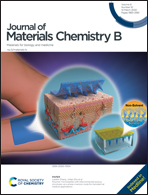Chlorin e6 and polydopamine modified gold nanoflowers for combined photothermal and photodynamic therapy†
Abstract
Combinational photo-based approaches with enhanced efficacy for cancer therapy have garnered increasing attention in recent years. In this work, a multifunctional system for synergistic photothermal and photodynamic cancer therapy was successfully prepared. The system consists of gold nanoflowers (AuNFs) conjugated with Chlorin e6 (Ce6), and then coated with a polydopamine (PDA) layer. AuNFs with diameters around 80 nm and a broad absorbance in the visible–near infrared (Vis–NIR) range of 500 to 800 nm, were successfully synthesized by a two-step process at 0 °C, using HAuCl4, ascorbic acid (AA), and hydroxylamine hydrochloride (NH2OH·HCl) as the reactants. Glutathione (GSH) molecules chemically anchored to the gold surfaces were used to provide addressable sites for Ce6 conjugated to GSH-AuNFs through an amidation reaction. A PDA layer was then wrapped outside the Ce6-GSH-AuNFs via self-polymerization of dopamine, which provided additional chemical modification and functionalization. Finally, the multifunctional PDA-Ce6-GSH-AuNFs were obtained. The content of Ce6 incorporated into the AuNFs was 14.0 wt%, and the singlet oxygen yield of PDA-Ce6-GSH-AuNFs was approximately 91.0% of that of free Ce6. PDA-Ce6-GSH-AuNFs showed better photothermal conversion efficiency (η = 23.6%), lower cytotoxicity, and faster cell internalization. Both in vitro and in vivo investigation of the combined treatment with a near-infrared (NIR) laser (660 nm for photodynamic therapy, and 808 nm for photothermal therapy) demonstrated that PDA-Ce6-GSH-AuNFs had excellent phototoxicity and synergistic effects of killing cancer cells. Hence, PDA-Ce6-GSH-AuNFs are a dual phototherapeutic agent that exhibits photodynamic and photothermal therapeutic effects and has potential application in enhanced cancer therapy.



 Please wait while we load your content...
Please wait while we load your content...